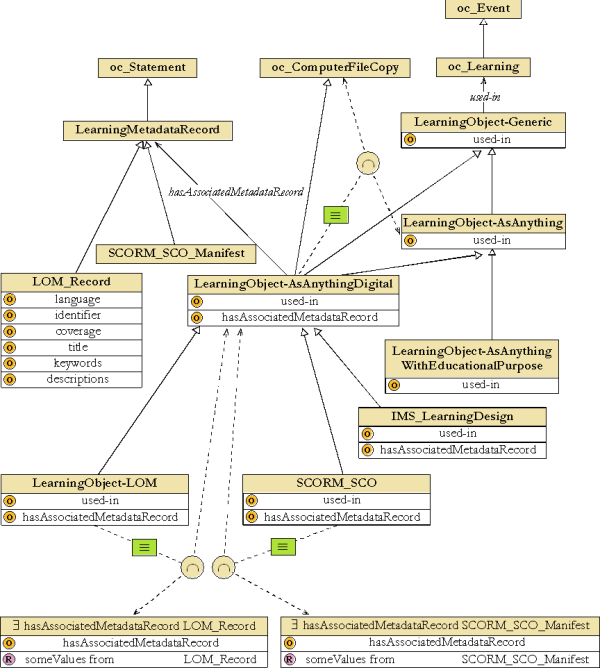 |
 |
| DOCUMENTATION |
| - Current repositoriesí shortages |
| - Towards a learning object flexible definition |
| - SLOR ontology |
| - A flexible repository: SLOR |
| FLEXIBLE METADATA STORING - ELSEM REPORT - |
| DOWNLOAD |
| WORKING GROUP |
| Further Work |
| SLOR ONTOLOGY |
|
As all the definitions described in the previous section can fit together, the recognition of such a diversity of conceptualizations, and the taxonomization of all of them, could be the basis of a neutral conceptual model. This new model would eventually provide the users with a number of different functionalities, adapted to each particular concept of learning object, and not necessarily restricted by only one of them. The flexibility is dealt with as a key issue for guiding the implementation. Based on a sound semantic model, defined by an ontology schema engineered using the Web Ontology Language (OWL), such a model would include all the definitions in McGreal’s study, thus supporting different types of learning objects. In short, the repository clients –final users, agents, and learning management systems– could, among other functionalities, add, retrieve, modify and search for learning objects regardless the definition of learning object used by the learning object creator. For example, client software using a LOM-based model would be able to retrieve learning objects from such repositories, even though the objects that fulfill the requirements of the client system were stored by a different system that was using the SCORM definition of learning object. From the different characterizations of learning object by McGreal, an ontology has been created (SLOR owl-file).
-- figure 2-- If learning can be considered an Event, any term linked to the
representation of learning activities, or declared to have an educational
purpose in some way, may be considered a learning object for practical
purposes. In Figure 2, all the classes pre-fixed by “oc”
are classes in the original Opencyc knowledge base. Therefore, the
term learning is represented by the class oc_Learning, which represents
the definition of learning in OpenCyc. The abstract representation
from which all the terms in McGreal’s terminology derive is
defined as the LearningObject-Generic class. An instance of this
class may be anything used_in oc_Learning. The LearningObject-AsAnything
class encompasses the broad definition of every possible meanings
of learning object. The LearningObject-AsAnythingWithEducationalPurpose
class has been defined to represent objects for which some declaration
of their pedagogical purpose exists, while the class LearningObject-AsAnythingDigital
represents digital objects. These two latter characterizations are
combined in current specifications of learning technology. In addition,
as current learning object standards and specifications suggest,
an individual of the class LearningObject-AsAnythingDigital should
be linked to at least one LearningMetadataRecord, by stating that
the domain of the property hasAssociatedMetadataRecord is the class
LearningMetadataRecord. LearningMetadataRecord is a generic term
that can be used to derive specific terms supporting each particular
specification such as LOM_Record or SCORM_SCO_Manifest. Any specification-specific
learning object is, by its own nature, something with a declared
educational purpose, which is at least tacit in the standardized
schema. Figure 2 shows the relationships between all the terms,
as described. Some examples: LearningObject-AsAnyThing: Books, notes, applets, web pages, a
paper with schemas, questionnaires, etc. |
